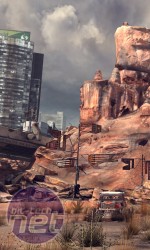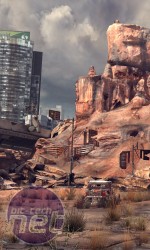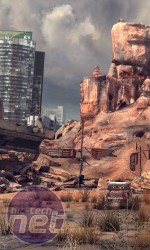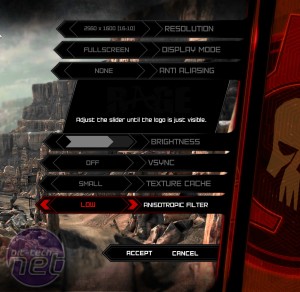
Rage Texture Tweaking
Rage's textures can sound very impressive when you first read about them, especially the environmental megatextures that are applied across whole levels using a new approach called virtual texturing, which is unique to id Tech 5. Intended to render repeating textures an obsolete idea, these textures are streamed in as required and can be 128,000 x 128,000 pixels in scale.The downside of id Tech 5's implementation of megatexture technology is that the textures take up a lot of storage space, explaining Rage's goliath 21GB footprint. The upside is that RAM otherwise hogged for loading textures is freed up for other tasks, while level design is freed up from an artistic standpoint.
Rage's auto-balancer system doesn't seem to want to use all of the detail available within the megatextures, however - prompting Nvidia and others to create guides on how to force higher detail textures through the use of a .cfg file. This file must be titled Rageconfig.cfg and located in the /base directory found within Rage's install folder. Entering the following text into the config files then allows you to force 8,192 x 8,192 textures, compared to the default of 4,096 x 4,096. Changing the figures can also force 16,384 x 16,384 textures.
vt_pageimagesizeuniquediffuseonly2 8192
vt_pageimagesizeuniquediffuseonly 8192
vt_pageimagesizeunique 8192
vt_pageimagesizevmtr 8192
vt_restart




LEFT TO RIGHT: Rage with auto-balanced textures, forced 4k textures, forced 8k textures and forced 16k textures
Unfortunately, while the increases in texture size sounds very impressive, the results are less so. We took screenshots of the same scene with Rage's default texture size (i.e. with the auto-balancer), as well as with 4k, 8k and 16k textures forced and, honestly, it was hard to tell the difference between them. Check for yourself by looking at the images above.
In fact, the only place where we could definitely point to an improvement was with the difference between the 4k textures and the higher settings - just look at the detail on the building in the background, for example. The 4k textures not only look worse than the 8k textures, they look bad compared to most current games.
There are areas where the id Tech 5 engine manages to shine, though, such as the improvements to the shadows and lighting engine compared to the previous id Tech 4 engine, but it's a shame that the main feature on which the engine is marketed is so underwhelming. Between the muddy textures of smaller items and the lack of visible improvement at higher settings, Rage feels disappointing on a graphical front - a shock considering id Software's history.
'You can choose to design a game around the specs of a high-end PC and make console versions that fail to hit the design point, or design around the specs of the consoles and have a high-end PC provide incremental quality improvements,' says id Software's John Carmack. 'We chose the latter.'
It's a telling comment, and one that could have easily damned the PC version of Rage to being dismissed as a flatly terrible game, but, as you can probably tell from the tone of our Rage review, we don't think that's the case. Rather, Rage is a hugely enjoyable game that offers a simply staggering amount of variation between its racing, shooting and RPG elements. It may lack the level of graphical customisation that PC gamers normally expect, but this isn't enough to hold back the game and Rage only rarely looks jarringly bad.
'Nowadays most of the quality of a game comes from the development effort put into it, not the technology it runs on,' says Carmack, but let us know your thoughts in the forums.

MSI MPG Velox 100R Chassis Review
October 14 2021 | 15:04











Want to comment? Please log in.